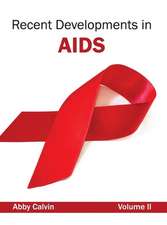Scientific Errors and Controversies in the U.S. HIV/AIDS Epidemic: How They Slowed Advances and Were Resolved
Autor Scott D. Holmberg M.D.en Limba Engleză Hardback – 29 dec 2007 – vârsta până la 17 ani
Preț: 305.93 lei
Preț vechi: 392.29 lei
-22% Nou
Puncte Express: 459
Preț estimativ în valută:
58.54€ • 62.60$ • 48.81£
58.54€ • 62.60$ • 48.81£
Carte tipărită la comandă
Livrare economică 17 aprilie-01 mai
Preluare comenzi: 021 569.72.76
Specificații
ISBN-13: 9780313347177
ISBN-10: 0313347174
Pagini: 240
Dimensiuni: 156 x 235 x 24 mm
Greutate: 0.52 kg
Editura: Bloomsbury Publishing
Colecția Praeger
Locul publicării:New York, United States
ISBN-10: 0313347174
Pagini: 240
Dimensiuni: 156 x 235 x 24 mm
Greutate: 0.52 kg
Editura: Bloomsbury Publishing
Colecția Praeger
Locul publicării:New York, United States
Notă biografică
Scott D. Holmberg, M.D., joined the Centers for Disease Control in 1982. As a Peace Corps Volunteer working in smallpox eradication in Ethiopia, he had become dedicated to a professional life of investigating and controlling epidemics. He then returned to the United States, and, after premedical courses, medical school, and residency, joined the CDC. The history of scientific errors and controversies in this book is based on his experience as Chief of Epidemiology for the CDC's Division of HIV/AIDS Prevention from 1986 to 2005. Holmberg has authored or co-authored more than 150 scientific articles about HIV/AIDS, and has received many awards from the CDC, the Department of Health and Human Services, and the U.S. Public Health Service, in which he served as a Commissioned Officer. He is a graduate of Columbia University College of Physicians and Surgeons and Emory University.
Recenzii
This book is an autopsy of errors. Drawing on his 20 years as chief of epidemiology in the division of the prevention of the human immunodeficiency virus (HIV) and the acquired immunodeficiency syndrome (AIDS) at the Centers for Disease Control and Prevention (CDC), Scott Holmberg dissects a litter of discarded theories and opinions about the epidemic to learn how they arose, were propagated, and were eventually corrected. The result is an instructive illustration of how errors afflict science at all levels, and it provides some thoughtful, if overly optimistic, observations on how to reduce their incidence. . . . offers a well-documented account that will be of interest not only to HIV and AIDS scholars but to anyone concerned with the role of error in modern medicine.
Part history, part narrative, and principally a scientific autopsy, this book is an insider's account of the errors, controversies, and corrections that have marked the first twenty-five years of the HIV/AIDS epidemic in the United States. It describes how these many scientific errors occurred, how they distracted researchers and the public, and how they were corrected. The author shows how scienfitic errors and controversies inevitably occur in the abscence, ignorance, or dismissal of good data, and the promotion of bad data or analyses. He suggests reforms of government processes, medical and scientific journal review, and graduate education that may help scientists recognize and correct error faster, enabling us to deal with future epidemics more efficiently.
.Hope for a cure sometimes creates a frenzy of expectation. In the chapter titled 'Early Drugs and Biomedical Interventions,' Holmberg expertly takes us through some of the thinking and activity surrounding ineffective HIV treatment compounds that were early research targets, such as peptide T, dextran sulfate, compound Q, interleukin 2, and in¬terferon alpha, and the hope and controversy that emerged during research phases..After reading this book, one wonders if there is some ingrained aspect of the public milieu, as well as perhaps permanent structural elements within the scientific community, that promote the kind of rollercoaster ride associated with the investigation of HIV/AIDS and the efforts of public programs to address the pandemic. In summary, the book presents the reader with an excellent view of scientific issues affected by errors and controversies in the US HIV/AIDS epidemic.'
Part history, part narrative, and principally a scientific autopsy, this book is an insider's account of the errors, controversies, and corrections that have marked the first twenty-five years of the HIV/AIDS epidemic in the United States. It describes how these many scientific errors occurred, how they distracted researchers and the public, and how they were corrected. The author shows how scienfitic errors and controversies inevitably occur in the abscence, ignorance, or dismissal of good data, and the promotion of bad data or analyses. He suggests reforms of government processes, medical and scientific journal review, and graduate education that may help scientists recognize and correct error faster, enabling us to deal with future epidemics more efficiently.
.Hope for a cure sometimes creates a frenzy of expectation. In the chapter titled 'Early Drugs and Biomedical Interventions,' Holmberg expertly takes us through some of the thinking and activity surrounding ineffective HIV treatment compounds that were early research targets, such as peptide T, dextran sulfate, compound Q, interleukin 2, and in¬terferon alpha, and the hope and controversy that emerged during research phases..After reading this book, one wonders if there is some ingrained aspect of the public milieu, as well as perhaps permanent structural elements within the scientific community, that promote the kind of rollercoaster ride associated with the investigation of HIV/AIDS and the efforts of public programs to address the pandemic. In summary, the book presents the reader with an excellent view of scientific issues affected by errors and controversies in the US HIV/AIDS epidemic.'














